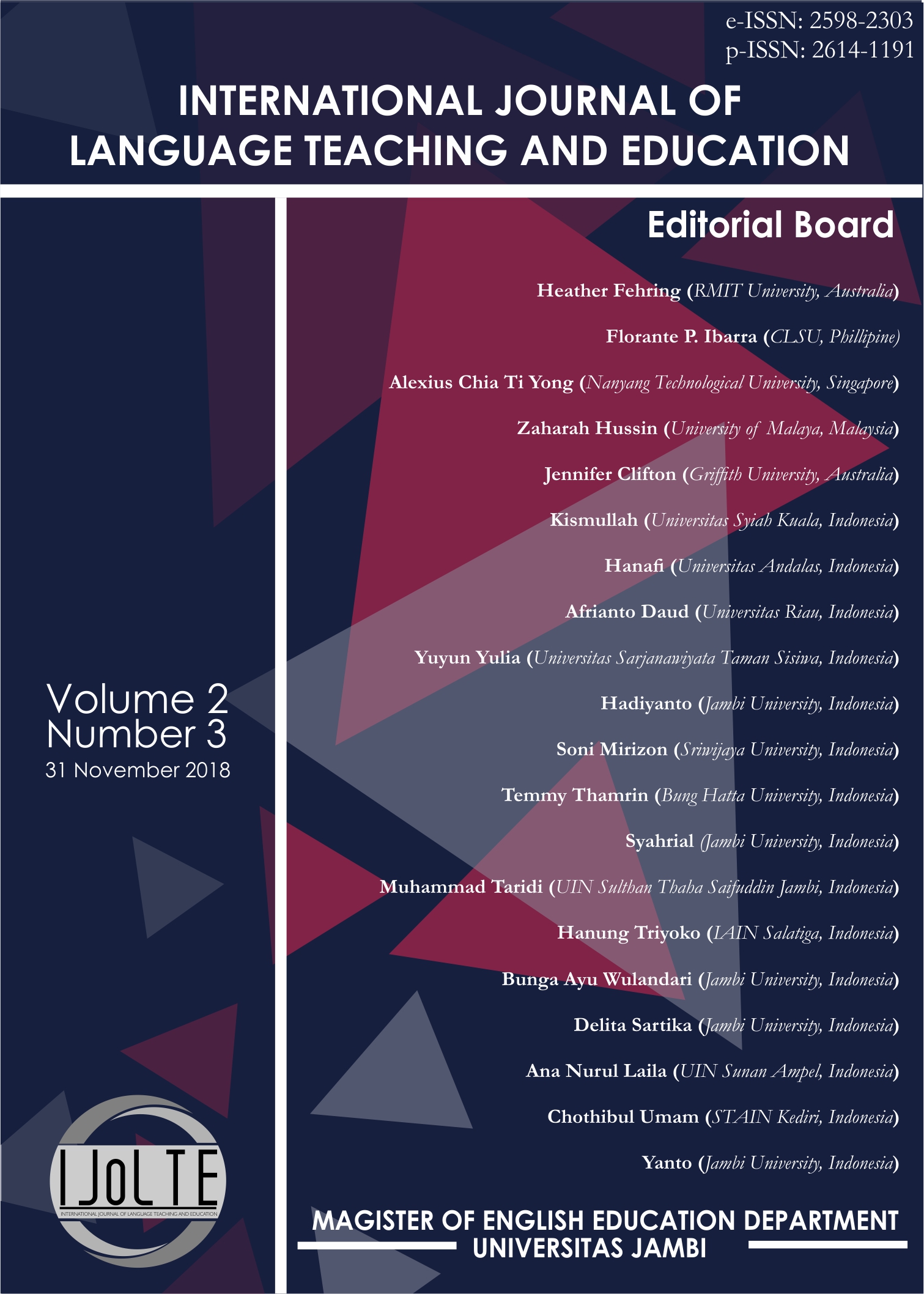Investigating the Integration Level of Information and Communication Technology (ICT) in the English Language Teaching
DOI:
https://doi.org/10.22437/ijolte.v2i3.5752Abstract
Information and Communication Technology (ICT) is perceived as a part of the core of education in this 21st century-learning. Experts have explored the integration of pedagogical ICT in teaching and learning recently. But none of them explored the teacher’s competence to integrate pedagogical ICT as they assess the extent to which ICT integrated by the teacher in teaching. This research aims to investigate the teacher competence levels to use ICT and the extent to which the ICT integrated by the teacher in English language teaching. Classroom observation and interview were used as data collecting technique to reach the objectives. To produce an in-depth description, this case study focuses on the description of the individual teacher as the target of the investigation. Teacher’s ICT competence levels were classified using professional framework rank ICT competence level (UNESCO, 2011). While SAMR model was used as the data analysis tool to determine the extent to which ICT integrated by the teacher in the English language teaching. The results of this research indicate that the teacher's competence to use ICT was still beginner. It means that the teacher is dominant with the use of basic features of presentation, word processor software such as powerpoint and Microsoft word and other digital resources. It is also reported that teacher’s ICT integration level with the domination at the substitution level and augmentation level. These findings reflect the ability of the teacher in integrating ICT in teaching. The teacher is considered only be able to use basic function in a limited number of computer application with only little change and improvement.
Downloads
Downloads
Published
Versions
- 2018-12-01 (1)
- 2018-12-01 (1)
How to Cite
Issue
Section
License
The Authors submitting a manuscript do so on the understanding that if accepted for publication, copyright of the article shall be assigned to International Journal of Language Teaching and Education (IJoLTe) and Magister Program of English Education Department, Universitas Jambi as publisher of the journal. Copyright encompasses rights to reproduce and deliver the article in all form and media, including reprints, photographs, microfilms, and any other similar reproductions, as well as translations.
IJoLTe keep the rights to articles that have been published. And, the authors are permitted to disseminate published article by sharing the link of IJoLTe' website. Authors are allowed to use their works for any purposes deemed necessary without written permission from IJoLTe with an acknowledgement of initial publication in this journal.
IJoLTe and Magister Program of English Education Department, Universitas Jambi, and the Editors make every effort to ensure that no wrong or misleading data, opinions or statements be published in the journal. In any way, the contents of the articles and advertisements published in IJoLTe are the sole and responsibility of their respective authors and advertisers.
If the article was jointly prepared by more than one author, any authors who submitting the manuscript warrants that he/she has been authorized by all co-authors to be agreed on this copyright and license notice (agreement) on their behalf, and agrees to inform his/her co-authors of the terms of this policy. IJoLTe will not be held liable for anything that may arise due to the author(s) internal dispute. IJoLTe will only communicate with the corresponding author.
By submitting the article/manuscript to this journal, the authors agree with this policy and consciously agree that IJoLTe does not provide royalties or other fees to the authors for their published articles. By agreeing this policy, IJoLTe ensures that published articles are publicly accessible and will be free of charge for the readers. No specific document sign-off is required.
Users of this website will be licensed to use materials from this website following the Creative Commons Attribution 4.0 International License. Please use the materials accordingly
You are free to:
- Share — copy and redistribute the material in any medium or format
- Adapt — remix, transform, and build upon the material for any purpose, even commercially.
- The licensor cannot revoke these freedoms as long as you follow the license terms.








1.png)
